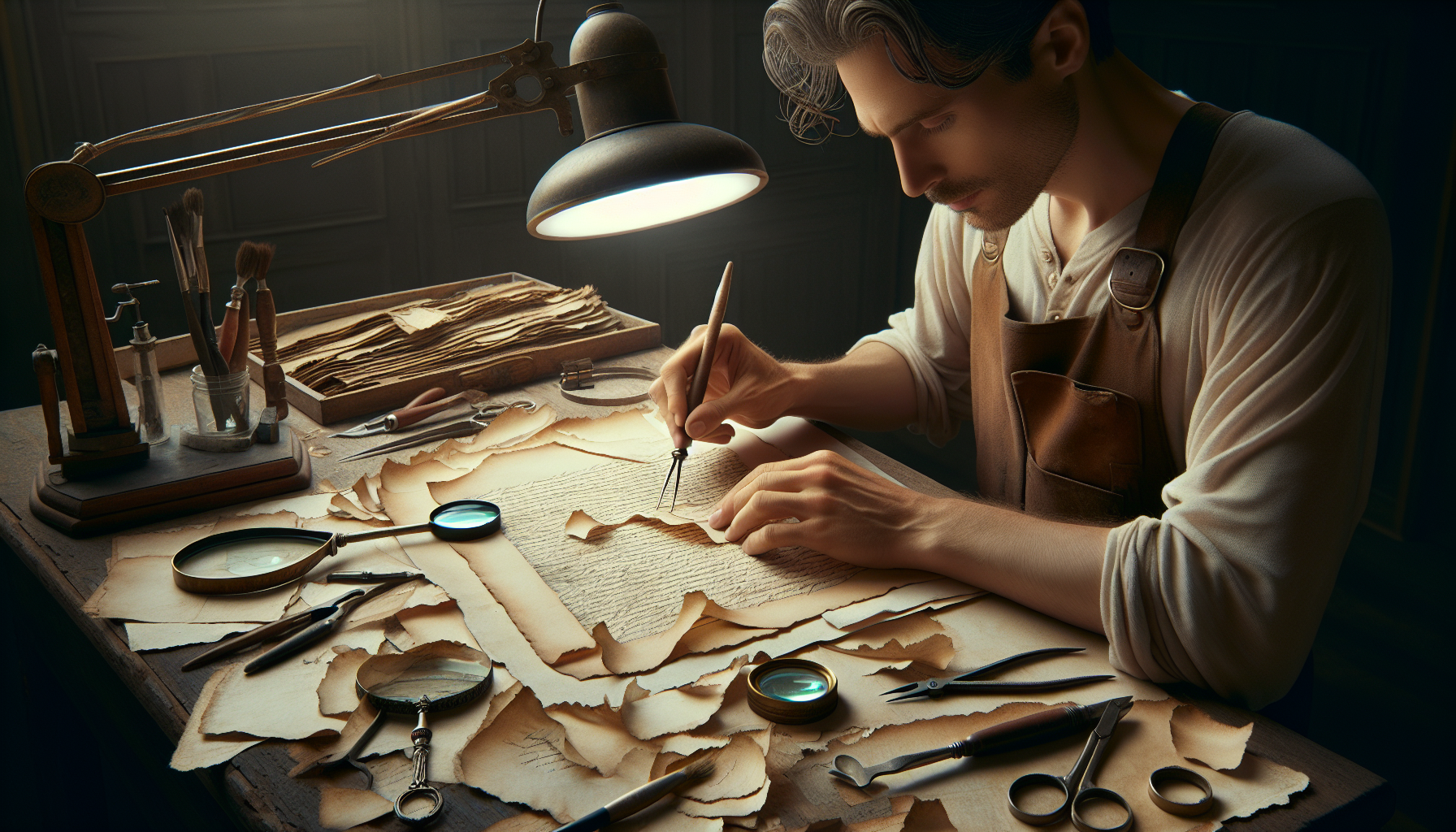In a world increasingly dominated by digital screens and fleeting electronic communications, there remains a profound and irreplaceable magic in the tactile experience of holding a piece of paper. Be it a letter penned by a loved one, a historic document, or an intricately illustrated map from a bygone era, paper carries with it a tangible connection to the past and the people who shaped it. Yet, as time marches on, these fragile treasures often bear the scars of their journey—torn edges, faded inks, and brittle surfaces that threaten to erase their stories forever. Enter the delicate and meticulous art of paper restoration, a craft that not only salvages these historical artifacts but breathes new life into them, allowing them to continue telling their tales for generations to come. 📜✨
The realm of paper restoration is a fascinating intersection of science, art, and history, where each project presents a unique puzzle to be solved. At its core, it is about understanding the material—knowing the composition of the paper, the type of ink used, and the environmental conditions that have contributed to its current state. This knowledge forms the foundation upon which expert restorers build their work, employing a combination of traditional techniques and cutting-edge technology to achieve results that are nothing short of miraculous. From painstakingly piecing together shards of brittle manuscripts to gently coaxing color back into faded illustrations, the process is both painstaking and deeply rewarding.
As we embark on this exploration of paper restoration, we will delve into the intricate processes involved in reviving damaged documents. We will uncover the methods used to stabilize fragile papers, prevent further deterioration, and repair tears and losses with remarkable precision. Additionally, we will explore the ethical considerations that restorers must navigate, balancing the desire to restore with the imperative to preserve the integrity and authenticity of the original artifact. These decisions often involve difficult choices and require a deep respect for the historical significance of each piece.
Furthermore, we will highlight the stories of some of the most renowned paper restoration experts who have dedicated their lives to this noble pursuit. Their passion and expertise are matched only by their reverence for the artifacts they work with, each one a custodian of our collective history. Through their eyes, we gain a deeper appreciation for the skill and dedication required to transform fragile and torn papers into revitalized works of art that continue to inspire awe and wonder.
Join us on this captivating journey into the world of paper restoration, where the past meets the present, and where the delicate balance of revive, restore, and renew becomes an art form in itself. Whether you are a history enthusiast, an art lover, or simply curious about the hidden stories within the pages of old books and documents, this exploration promises to enlighten and inspire. Let us uncover the secrets of paper restoration and witness the transformation of timeworn fragments into timeless treasures. 🌟
Understanding the Importance of Paper Conservation
Paper, as a medium of communication and documentation, has played an invaluable role in human history. Whether it’s ancient manuscripts, family letters, or important official documents, the preservation of paper ensures that history is tangible, stories are remembered, and knowledge is transmitted across generations. However, paper is inherently fragile and susceptible to a variety of environmental and physical threats, which makes the field of paper conservation both essential and intricate.
The process of paper conservation involves a meticulous blend of science and art. Conservationists employ a range of techniques to stabilize and restore damaged paper, ensuring its longevity for future appreciation and study. This is not just about maintaining aesthetics but also about preserving the integrity and historical context of the document. The expertise involved in this process often requires a deep understanding of chemistry, art history, and fine arts.
To underscore the importance of paper conservation, consider the multifaceted threats that paper faces: environmental factors like humidity, light, and temperature fluctuations; biological factors such as mold and pests; and human factors including handling, folding, and improper storage. Each of these elements can cause irreversible damage to paper artifacts. Therefore, the role of a paper conservator is crucial in diagnosing these issues and applying appropriate restoration techniques.
Common Issues Faced by Fragile and Torn Papers
When dealing with fragile and torn papers, one of the most common problems is the material’s vulnerability to tearing. This can be exacerbated by improper handling or storage. Tearing often results from weaknesses in the paper fibers, which can be caused by factors like acidity or physical strain. The challenge for conservators is not just to repair the tear but to ensure the paper remains stable and usable for the future.
Another prevalent issue is discoloration, which often results from exposure to light or chemical reactions within the paper itself. This can manifest as yellowing or darkening and can significantly impact the visual appeal and readability of the document. Discoloration is often addressed through careful cleaning and, in some cases, deacidification processes that neutralize harmful acids in the paper.
Mold and mildew are also significant threats to paper artifacts, particularly in environments with high humidity. These biological contaminants not only cause staining and odor but can also lead to further deterioration of the paper fibers. Preventive measures such as climate control and proper ventilation are critical, alongside active cleaning and treatment to remove mold spores without causing further damage.
Techniques in Paper Conservation
Conservators use a variety of techniques tailored to the specific needs of each paper artifact. For instance, mending tears might involve the use of Japanese tissue paper, which is applied with wheat starch paste. This technique is revered for its strength and minimal impact on the original material, ensuring that repairs are as unobtrusive as possible.
Deacidification is another essential process, especially for documents printed on wood pulp paper from the late 19th and early 20th centuries, which are prone to acid decay. This technique involves treating the paper with alkaline substances to neutralize acids and extend the document’s lifespan. It’s a complex procedure that requires careful testing and application to avoid adverse reactions.
In addition to these hands-on techniques, conservators also employ digital tools to assist in the preservation of content. High-resolution scanning, for example, provides a digital backup that can be used for research and public access, reducing the need for physical handling of the original document. This digital preservation is an increasingly important aspect of paper conservation, providing a balance between access and preservation.
The Role of Technology in Modern Paper Conservation
Technology has become an indispensable tool in the field of paper conservation. Advanced imaging techniques, such as multispectral imaging, allow conservators to see beneath the surface of documents, revealing hidden text or images that are invisible to the naked eye. This can be particularly useful in the restoration of documents where ink has faded or been obscured over time.
Moreover, 3D scanning technologies enable the precise documentation of a paper’s texture and structure, providing detailed data that can assist in the conservation process. These technologies not only aid in the restoration process but also in research and education, offering insights into the document’s history and production techniques.
Digital platforms also play a crucial role in sharing information and techniques among conservators worldwide. Online databases and collaborative networks allow for the exchange of knowledge and experiences, enhancing the overall quality and consistency of conservation practices. This global community fosters innovation and ensures that conservators have access to the latest research and methodologies.
Comparative Table of Techniques
To illustrate the variety of techniques used in paper conservation, see the comparative table below:
| Technique | Purpose | Materials Used | Advantages |
|---|---|---|---|
| Japanese Tissue Repair | Mending tears | Japanese tissue, wheat starch paste | Strong, minimal impact on original |
| Deacidification | Neutralize acids | Alkaline substances | Prolongs lifespan, stabilizes paper |
| Digital Scanning | Preservation and access | High-resolution scanners | Reduces physical handling, provides backup |
How to Care for Your Paper Artifacts at Home
For individuals who possess personal collections of paper artifacts, understanding basic preservation techniques can help protect these valuable items. The first step is proper storage, which involves using archival-quality boxes and folders that are acid-free and lignin-free to prevent chemical degradation of the paper.
Controlling environmental conditions is also crucial. Paper should be stored in a stable environment with consistent temperature and humidity levels. Avoid areas with direct sunlight or fluctuating temperatures, such as attics or basements. Use a hygrometer to monitor humidity levels and consider using a dehumidifier in damp areas.
Handling practices are equally important. Always wash and dry your hands before touching paper artifacts, and consider wearing cotton gloves for particularly fragile items. When displaying documents, use UV-filtering glass to protect them from harmful light exposure. By implementing these practices, you can help ensure the longevity of your cherished paper artifacts.
Watch This Video for More Tips
For a visual guide on paper preservation, watch this informative video titled “Conservation Basics: Caring for Your Paper Documents” by the Conservation Lab Channel: Watch Video.
Remember, while these tips can help preserve your documents, complex restoration should always be undertaken by professional conservators to ensure the best care and preservation of valuable paper artifacts.

Conclusion
In conclusion, the journey through the delicate art of paper restoration—Revive, Restore, Renew: Transforming Fragile and Torn Papers with Expert Care and Precision—highlights not only the technical expertise required in this field but also the profound historical and emotional significance embedded within each piece of paper. We embarked on this exploration by first understanding the fragility of aged documents and the various factors contributing to their deterioration, such as exposure to light, humidity, and improper storage. These factors, if not addressed, can lead to irreversible damage, emphasizing the need for immediate and expert intervention.
We then delved into the meticulous process of paper restoration, which involves several stages from assessment and cleaning to mending and preservation. Each step requires a unique set of skills and knowledge, showcasing the blend of science and art in this discipline. The careful selection of materials, such as Japanese tissue paper and appropriate adhesives, plays a critical role in ensuring that the restoration process not only repairs but also enhances the longevity of these precious documents.
The significance of paper restoration extends beyond the technicalities; it is about preserving cultural heritage and personal memories. Restored documents—be they historical manuscripts, family letters, or artistic prints—serve as tangible connections to our past, offering insights and stories that might otherwise be lost to time. This highlights the cultural responsibility that rests upon restorers’ shoulders and underscores the importance of investing in and supporting this vital work.
Furthermore, the article underscores the transformative power of paper restoration in both public and private realms. In museums and archives, restored documents allow historians and researchers to access valuable information that can shape our understanding of history. In personal collections, the restoration of letters, photographs, or artworks can rejuvenate a family’s heritage, providing future generations with a sense of identity and continuity.
Recognizing the importance of this craft invites us to consider how we, as individuals and communities, can contribute to the preservation of our paper-based heritage. Simple actions, such as ensuring proper storage conditions, supporting local conservation efforts, or even pursuing training in restoration techniques, can make a significant difference. By valuing and protecting our paper-based artifacts, we ensure that they continue to educate and inspire future generations.
In closing, the art of paper restoration is a testament to human creativity and dedication, transforming fragile and torn remnants into restored and renewed treasures. This process not only conserves physical objects but also preserves the intangible stories and emotions they carry. As you reflect on the insights shared in this article, I encourage you to think about the papers in your life that may benefit from expert care. Consider sharing this knowledge with others, discussing the importance of preservation, or even engaging with professionals in the field to learn more about how you can contribute.
Let this journey of Revive, Restore, Renew inspire you to appreciate the fragile beauty of paper and the transformative power of restoration. By doing so, we not only honor our past but also enrich our present and future. Share this article with friends and colleagues who may find it enlightening, and let’s continue the conversation on how we can collectively protect and celebrate our paper heritage. 🌟
For further reading on paper restoration techniques and best practices, consider visiting resources such as the American Institute for Conservation (https://www.culturalheritage.org/) or the Library of Congress Preservation Directorate (https://www.loc.gov/preservation/). These organizations provide invaluable guidance and support for those interested in the field of conservation and restoration.
Thank you for joining us on this exploration of preserving our past through the expert care and precision of paper restoration. Let’s keep the dialogue going, and together, we can ensure that our paper treasures continue to inspire and educate for generations to come.
Toni Santos is a visual storyteller and archival artisan whose creative journey is steeped in the bold colors, dramatic typography, and mythic imagery of old circus posters. Through his artistic lens, Toni breathes new life into these once-lurid canvases of wonder, transforming them into tributes to a golden era of spectacle, showmanship, and cultural fantasy.
Fascinated by the visual language of vintage circuses — from roaring lions to gravity-defying acrobats, from hand-painted banners to gothic typefaces — Toni explores how these posters once captured the imagination of entire towns with nothing more than ink, illusion, and a promise of awe. Each composition he creates or studies is a dialogue with history, nostalgia, and the raw aesthetics of entertainment on the move.
With a background in handcrafted design and visual heritage, Toni blends artistic sensitivity with historical insight. His work traces the forgotten typographies, chromatic choices, and symbolic flair that defined circus marketing in the 19th and early 20th centuries — a time when posters were not just advertisements, but portable portals to dreamworlds.
As the creative force behind Vizovex, Toni curates collections, illustrations, and thoughtful narratives that reconnect modern audiences with the magic of old circus art — not just as ephemera, but as cultural memory etched in paper and pigment.
His work is a tribute to:
The flamboyant storytelling of early circus posters
The lost art of hand-lettered show promotion
The timeless charm of visual fantasy in public space
Whether you’re a vintage print enthusiast, a circus history lover, or a designer inspired by antique aesthetics, Toni invites you into a world where tigers leap through fire, strongmen pose in perfect symmetry, and every corner of the poster whispers: Step right up.





